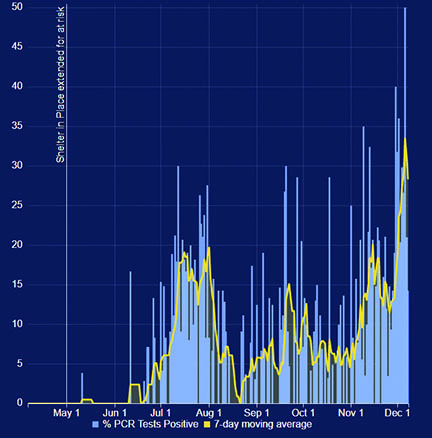Rate of Rabun positive test results highest in North Georgia

CLAYTON—In the past two weeks, Rabun County had the highest percentage of positive COVID-19 test results in North Georgia, and the fourth-highest percentage in the entire state, the Georgia Department of Public Health (GDPH) reported Tuesday.
There were 125 new COVID-19 cases reported for Rabun County in the two-week period, bringing the cumulative total to 736 positive test results.
An influx of visitors over the Thanksgiving holiday, coupled with a population shift that has seen the county’s population nearly double over the past several months contributed to the dramatic increase, local health officials say.
“We had a huge number of people in our county Thanksgiving week,” said Kim Ingram, Quality Control Officer at Mountain Lakes Medical Center. “We have really high community transmission, a real high positive rate and that’s translating into people coming in (to the hospital) pretty sick.”
It’s unwelcome news at the worst possible time.
Health care professionals say the combination of the holiday season, the cold/flu season, the arrival of colder weather to keep people indoors and general COVID fatigue mean the COVID-19 pandemic will almost certainly get worse before it gets better.
“By this time next week, it’s going to be ugly, and it’s going to be ugly for about 90 days,” said Ingram.
Local hospital officials joined two teleconferences with health care providers across Georgia last Friday to discuss COVID-19 issues.
The consensus was that the short-term outlook looks grim.
“We’re seeing a huge increase not only of patients that we are testing that test positive, but of those patients coming into our emergency room already knowing they are COVID positive,” said Rachel Cowart, chief nursing officer at MLMC. “These patients are much, much sicker.”
Hospital near capacity
Hospitals across North Georgia are at or near capacity with the expected peak number of cases not yet in sight.
MLMC has beds available and the recommended therapeutic treatments for the disease, but a lack of specialists—particularly pulmonologists—means the local hospital must rely on larger hospitals for support in treating the surge.
Northeast Georgia Medical Center in Gainesville—which provides such support for MLMC--is “basically at capacity,” said Cowart.
“We have struggled with transfers,” Cowart said. “Northeast Georgia has been able to take a couple, we transferred one patient to Asheville, and we flew a patient to Northside Duluth. We’re feeling the pinch of the surge.”
Tracking COVID cases
The best statistic for understanding how rapidly the disease is spreading is the percentage of patients who are tested and return positive results.
“The CDC says that anything over 5 percent means you have community spread, people in the community are giving it to each other,” Ingram said.
Rabun County’s 7-day average of patients testing positive was 30.8 percent as of Monday. It has been over 40 percent several times in the past week.
“If you look at the per capita full-time residents, it’s a scary number,” Cowart said.
Twelve Rabun County residents have died from the disease as of Monday.
“One way to look at it is that of the approximately 70 people who have been hospitalized (due to COVID-19), 12 of them have died,” Ingram said.
Hospital is prepared
Ingram said for now, MLMC has the staffing, bed space and supplies to meet demand. The lack of access to medical specialty backups is the biggest challenge the hospital is facing at the moment.
“We don’t have pulmonology, we don’t have critical care,” she added. “Sometimes that forces us to transfer, when we might be able to maintain the patient if we had those services. We’d be glad to keep them here. We have the beds, we have the staff, we have the space. We just need some doctor backup.”
Rabun County Commissioner Kent Woerner said Friday one of the county recreation department gymnasiums has been set up as an emergency backup to house COVID-19 patients should it become necessary.
“Where the staffing comes from, I have no idea,” Woerner said.
New COVID vaccine on the way
MLMC expects to begin receiving doses of the Pfizer COVID-19 vaccine sometime after Dec. 14-15.
“That is the first vaccine that has been authorized,” Ingram said. “The first round will go to health care workers and nursing home residents.”
The vaccine, which must be maintained at sub-zero temperatures, will be shipped on dry ice.
“It has to be mixed,” Ingram said. “It comes as a powder. A vial has 5 doses in it, and it has to be reconstituted as a liquid. Once you take it out, you have to have people line up immediately to take it.”
Two doses of the vaccine will be needed to provide the full protective effects.
“It’s sort of like with measles and mumps, where you take multiple doses,” Ingram said. “It’s actually made out of genetic material, there’s no virus in it. It’s the first time we’ve had a vaccine like this. The first dose you get primes the pump. It gets your body to begin the process. That takes about 21 days, then you come back and get the second dose. You’re not going to take one shot and be immune.”
Even people who have been diagnosed with COVID-19 and recovered will need to take the vaccine when it is available,” Ingram said.
“There’s no guarantee they have immunity (from having recovered from the disease),” Ingram said. “This is uncharted territory we’re in here.”
Following guidelines can make a difference
Meanwhile, Cowart urged everyone to follow state and federal guidelines on using masks, washing hands and limiting social contact as a way to help slow the spread of the disease.
“At the end of the day, hospitals can no longer be the front line,” she said. “The front line has to be the people taking the precautions outside of the hospital so they don’t have to come here. We have to stop this war of attrition, and the first step is we have to slow the death rate, and slow the overwhelming of our hospitals. We will learn so much about this virus over the next 100 years. Right now, we have to go with what knowledge we have to slow the horrific rate at which people are getting incredibly ill and dying. We still have a lot to learn about all of this.”

